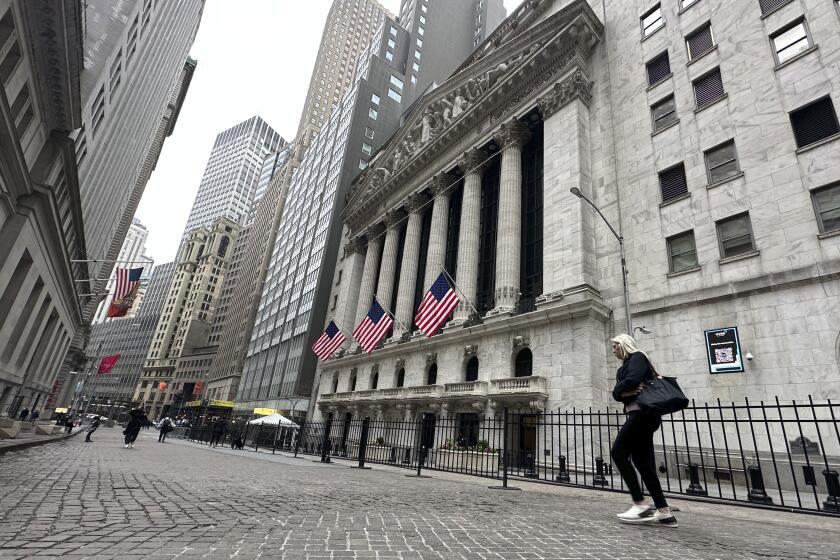Home Market Shows Hints of Cooling Off
When Curtis Jang put his three-bedroom, two-bath South Pasadena home up for sale in mid-May, he was confident it would sell quickly.
At $598,000, it was one of the least expensive houses on the market in a suburb known for its top-notch schools.
And less than a month earlier, his next-door neighbor sold his house in four days and for more than the asking price. But after two weeks and no offers, Jang slashed his asking price to $550,000.
“It was a question of timing,” said the 38-year-old director of an Alhambra tutoring service. “I put my house on the market two weeks too late.”
To be sure, Southern California’s exuberant house party is still going strong. The median price of a house in the six-county region has risen more than 20% year over year for 11 consecutive months as the supply of homes for sale has fallen near an all-time low.
But Wednesday’s action by the Federal Reserve, which raised the benchmark federal funds rate by one-quarter of a percentage point, threatens to throw a bit of cold water on the region’s housing prices, where signs of a cooling-off period have already emerged.
Mortgage rates aren’t directly tied to the Fed’s short-term rate. Instead, the mortgage market takes its cue from long-term bond yields. Investors determine those yields, based in part on what the Fed is doing with short-term rates and also on long-term inflation expectations.
The steady uptick in rates ahead of the Fed’s move Wednesday hasn’t been lost on thousands of Southland homeowners, who are rushing to put up “for sale” signs in hopes of selling their homes for as much as possible.
That means buyers have more properties to choose from. Spring and summer are usually the busiest seasons for residential real estate. But this year some prospective homeowners say they are thinking twice about taking on a more costly loan for a house that may be priced too high.
“Buyers are done overpaying for properties,” said Pat Veling, president of Real Data Strategies, a real estate research and consulting firm in Brea. “The biggest challenge now is reminding buyers and sellers what a normal market is.”
San Gabriel Valley broker Emily Hon said she was starting to see fewer homes in her area that were fetching the asking price.
The reason, Hon and others said, is simple: There are more houses up for sale -- and buyers know it. In the last two months, inventories of unsold houses and condominiums have risen dramatically in many different kinds of neighborhoods.
According to data compiled by Veling:
* In inland Corona, the number of homes listed rose 48% from March to May to 160 from 108.
* In exclusive Cota de Caza, buyers at the end of May had a choice of among 93 listings, compared with 59 the previous month.
* In Long Beach, there were 485 properties on the market in late May, up from 276 the previous month.
Historically speaking, Southern California’s housing supply is still quite low. Even with the increase in listings in the last two months, the available supply of existing single-family, detached homes will last only 2.2 months, according to the California Assn. of Realtors. That’s down slightly from a 2.3-month supply a year ago.
Still, “the rise in rates has certainly created a turning point in the market,” said Leslie Appleton-Young, chief economist for the Realtors group. It has spurred more activity “on the side of sellers,” she said. At the same time, “buyers are becoming more choosy.”
At the beginning of the year, the monthly payment on a $350,000 mortgage (principal and interest only) was $2,064. At today’s rates, that has jumped to $2,155 -- and is poised to go even higher with future Fed rate increases in the offing.
For every 1 percentage point increase in mortgage rates, about 120,000 additional households are unable to afford a median priced home, according to the California Assn. of Realtors.
At the same time, the seemingly endless rise in prices may be starting to run out of steam. After languishing for much of the 1990s, the median price of a Southland house has nearly doubled in the last five years, to $391,000 in May, the latest figure available, according to DataQuick Information Systems.
At this point, some buyers are deciding they’ve had enough.
Just a month ago, Jessica Ramos and her husband felt they “had to buy.” The Highland Park couple made an offer on an 1,100-square-foot three-bedroom, one-bath house for $430,000 even though it wasn’t exactly what they wanted. They soon withdrew from the deal, sensing that they might have been overpaying.
“I don’t want to be that person who ends up paying $40,000 more than it’s worth,” said the 29-year-old school psychologist. “We’re not as hasty to make a bid now.”
For one thing, Ramos said she encountered few looky-loos at weekend open houses, easing the pressure to bid. In addition, she keeps track of new listings on real estate websites and watches for price reductions.
But no one is predicting a significant decline in the cost of housing anytime soon. A recent forecast by economists at the UCLA Anderson School of Management predicted that home prices would not significantly decline this year or in 2005, but the rate of appreciation is expected to cool.
“The only thing that will fall will be sellers’ expectations,” Veling said.
Jang knows all about adjusting expectations. But he’s not complaining. The home he bought eight years ago for $220,000 is now listed at $550,000 and he has an offer on it.
“That certainly takes the sting out of not selling it right away,” he said.






